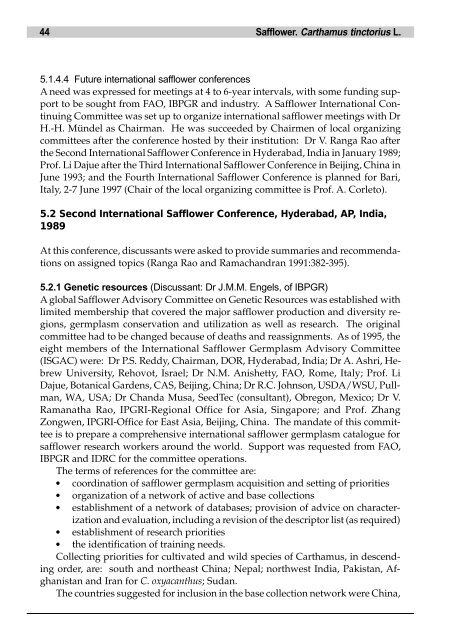Safflower, Carthamus tinctorius L. - Bioversity International
Safflower, Carthamus tinctorius L. - Bioversity International
Safflower, Carthamus tinctorius L. - Bioversity International
You also want an ePaper? Increase the reach of your titles
YUMPU automatically turns print PDFs into web optimized ePapers that Google loves.
44 <strong>Safflower</strong>. <strong>Carthamus</strong> <strong>tinctorius</strong> L.<br />
5.1.4.4 Future international safflower conferences<br />
A need was expressed for meetings at 4 to 6-year intervals, with some funding support<br />
to be sought from FAO, IBPGR and industry. A <strong>Safflower</strong> <strong>International</strong> Continuing<br />
Committee was set up to organize international safflower meetings with Dr<br />
H.-H. Mündel as Chairman. He was succeeded by Chairmen of local organizing<br />
committees after the conference hosted by their institution: Dr V. Ranga Rao after<br />
the Second <strong>International</strong> <strong>Safflower</strong> Conference in Hyderabad, India in January 1989;<br />
Prof. Li Dajue after the Third <strong>International</strong> <strong>Safflower</strong> Conference in Beijing, China in<br />
June 1993; and the Fourth <strong>International</strong> <strong>Safflower</strong> Conference is planned for Bari,<br />
Italy, 2-7 June 1997 (Chair of the local organizing committee is Prof. A. Corleto).<br />
5.2 Second <strong>International</strong> <strong>Safflower</strong> Conference, Hyderabad, AP, India,<br />
1989<br />
At this conference, discussants were asked to provide summaries and recommendations<br />
on assigned topics (Ranga Rao and Ramachandran 1991:382-395).<br />
5.2.1 Genetic resources (Discussant: Dr J.M.M. Engels, of IBPGR)<br />
A global <strong>Safflower</strong> Advisory Committee on Genetic Resources was established with<br />
limited membership that covered the major safflower production and diversity regions,<br />
germplasm conservation and utilization as well as research. The original<br />
committee had to be changed because of deaths and reassignments. As of 1995, the<br />
eight members of the <strong>International</strong> <strong>Safflower</strong> Germplasm Advisory Committee<br />
(ISGAC) were: Dr P.S. Reddy, Chairman, DOR, Hyderabad, India; Dr A. Ashri, Hebrew<br />
University, Rehovot, Israel; Dr N.M. Anishetty, FAO, Rome, Italy; Prof. Li<br />
Dajue, Botanical Gardens, CAS, Beijing, China; Dr R.C. Johnson, USDA/WSU, Pullman,<br />
WA, USA; Dr Chanda Musa, SeedTec (consultant), Obregon, Mexico; Dr V.<br />
Ramanatha Rao, IPGRI-Regional Office for Asia, Singapore; and Prof. Zhang<br />
Zongwen, IPGRI-Office for East Asia, Beijing, China. The mandate of this committee<br />
is to prepare a comprehensive international safflower germplasm catalogue for<br />
safflower research workers around the world. Support was requested from FAO,<br />
IBPGR and IDRC for the committee operations.<br />
The terms of references for the committee are:<br />
● coordination of safflower germplasm acquisition and setting of priorities<br />
● organization of a network of active and base collections<br />
● establishment of a network of databases; provision of advice on characterization<br />
and evaluation, including a revision of the descriptor list (as required)<br />
● establishment of research priorities<br />
● the identification of training needs.<br />
Collecting priorities for cultivated and wild species of <strong>Carthamus</strong>, in descending<br />
order, are: south and northeast China; Nepal; northwest India, Pakistan, Afghanistan<br />
and Iran for C. oxyacanthus; Sudan.<br />
The countries suggested for inclusion in the base collection network were China,

















